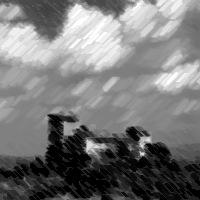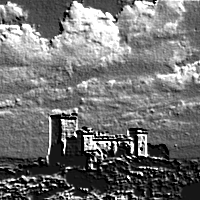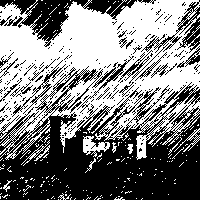Home |

Narni
Narni, province of Terni, in the region of Umbria. Built on a hill 240 metres a. s. l., 20,570 inhabitants, is the geographic middle of Italy.
The town has outstanding views over the River Nera valley and offers artisitic and archaelogical itineraries, plus an abundance of natural history for the tourist.
HISTORICAL INFORMATION:
The first historical document, mentioning the town, is dated 600 BC, when the town was called Nequinum.In 299 BC, Narni was a Roman colony under the name of Narnia In 233 BC, with the construction of the Via Flaminia, Narni became of major importance in 90 BC, Narnia became a municipality.
The first Christian Bishop of Narni, Giovenale from Carthage, was chosen in 368 AD and later was consecrated as Saint Patron of the town. In the 11th century it established its power as a free "Comune" (autonomous town). Between the 12th and the 14th century it reached its greatest period of splendour and developed a school of painting and goldsmiths.
Many artists of the Renaissance period produced works for clients and patrons in Narni: Rossellino, Ghirlandaio, Gozzoli, Vecchietta, Antoniazzo Romano and Spagna. In 1527, the Lanzichenecchi destroyed Narni almost completely. Slowly the walls, buildings and churches were re-built and by the end of the century, Narni had been re-established.
Many famous people have been born in Narni, including the emperor Cocceio Nerva, Gattamelata, the Beata Lucia, Berardo Eroli, Galeotto Marzio and S.Cassio. A VISIT TO THE TOWN:
A VISIT TO THE TOWN:
THE CHURCHES The CATHEDRAL (dedicated to San Giovenale, first Bishop and Patron of the town).
Romanesque building (11th and 12th centuries), it was consacreted in 1145 and enlarged in the 14th century.
The porch and arch date back to 1497. Below it you can see the impressive main portal (Portale Maggiore), built in the 12th century. Inside, the church is formed in a Latin cross plan, divided into three naves, the fourth nave being added to the main plan in 1400.
On the right hand side of the entrance, you can see the sepulchre of Saint Giovenale and Saint Cassio (Sepolcro di SS Giovenale e Cassio). The sepulchre is one of the most ancient christian monuments in Umbria, with a sarcophagus, which kept the body of San Giovenale, dating back to the 7th century, above it is a mosaic from the 9th century.
Noteworthy are also many paintings and works by Vecchietta, Rossellino and local artists. CHURCH OF SAN FRANCESCO: (13th century) enlarged in the 14th century. It was built on the site place of an oratory where the Saint lived during his stay in Narni. On the walls are important frescos by the local school of Mezzastris and Torresani.
CHURCH OF SANTA MARIA IMPENSOLE, romanesque building (1175).
Below the porch there are three important portals; the central one is of particular interest. The interior is divided into three naves. You can admire the capitals of the central nave's columns. In the crypt there are the remains of a building and a well of the Roman period and tombs.
SAN DOMENICO (the former SANTA MARIA MAGGIORE). built in the 12th century, today it is an exhibition area and houses the Library and the Historical Archives. You can also see the high bell tower and the two entrances of the beautiful façade. The interior has three naves divided by piers with round arches.
You can see here a Cosmatesque floor, the chapel of Gattamelata, a Narni born mercenary soldier of the medieval period a sepulchre dedicated to Gabriele Massei and a carved marble tabernacle. In the first nave you can see a fresco representing the Madonna between San Domenico and San Tomasso and some other paintings by Federico Zuccari (1570).
Through the garden of S.Bernardo you have access to the old San Domenico church which is completely underground (SOTTERANEI DI SAN DOMENICO).
Inside these rooms you will find a noteworthy little chapel, as well as a prison from the Inquisition's times CHURCH OF S.AGOSTINO (14th century) still preserves a rich art collection. Among the works are a beautiful wooden ceiling by F.Benincasa, a fresco by Piermatteo d'Amelia plus works by Torresani and A.Romano.
THE PALACES:
On the Piazza dei Priori you can see the PALAZZO DEI PRIORI (the Priori Palace). On the right of the portal, there is a stone pulpit, from which proclamations were read, above the pulpit is a high bell tower. Two arches open onto a large porch and in the middle of it, a stone pier holds up the cross-vaulting. The Palace was built in 1275 and it is ascribed to Gattapone da Gubbio.
On the other side of the piazza you can see the PALAZZO COMUNALE (Town Hall) created from the union of three towers in 1273. On the façade you can see parts of old inscriptions. On the right side there is a portal from the 15th century and above it a row of 7 small columns and bas-reliefs. In the entrance hall you will find a Roman tomb and a Well dated 1400, plus a series of antique measurements and a lapidary collection.
In the Council Hall you can admire The Coronation of the Virgin (Incoronazione della Vergine) by Ghirlandaio (1486) and the Stigmata of Saint Frances (San Francesco Stimmatizzato) by Spagna.
PALAZZO SCOTTI, built in 1500, decorated with frescos by Zuccari (1581). PALAZZO CARDOLI (15th century) PALAZZO CAPOCACCIA (1545) ERASMO GATTAMELATA'S HOUSE THE TOWERS In the town remain many towers, being the typical medieval dwelling places, the most important are: the Torre de Marzi (Marzi's Tower) where Galeotto Marzio, a humanist of the 15th century, was born.
The Tower of Palazzo dei Priori (13th century), the civic Tower and many others. THE GATES were the passages through the city walls PORTA DELLA FIERA (or PORTA NUOVA) attributed to Vignola, the PORTA POLELLA, another City-Gate which dates back to the 13th century, PORTA TERNANA (or PORTA DELLE ARVOLTE) wanted by Pope Sisto V, PORTA ROMANA (1545) and PORTA PIETRA (13th century).
 Walking along the narrow streets
of the town's upper part, you can reach the Castle (ROCCA ALBORNOZ) built around 1370,
ascribed to Ugolino di Montemarte, on the orders of Cardinal Egidio Albornoz.
Walking along the narrow streets
of the town's upper part, you can reach the Castle (ROCCA ALBORNOZ) built around 1370,
ascribed to Ugolino di Montemarte, on the orders of Cardinal Egidio Albornoz.
The Rocca was a very important fortress, because of its strategic position: it could control any invasion against the Papal State.You can admire the magnificient walls and towers and enjoy the view of the area and the Apennine mountains. EXCURSIONS PONTE D'AUGUSTO: the famous Augustus'bridge was built in 27 BC, it was 160m long. The ancient consular road Via Flaminia leading to Carsulae (San Gemini) passed over it.
The remaining arch is 30 m high.
LO SPECO DI SAN FRANCESCO:
A Franciscan hermitage founded in 1213 by the Saint himself, 18 km from Narni. It still preserves the franciscan atmosphere and its pure architectural lines remain. It was completed in 1400, still following the franciscan style. The frescoes date back to the 14th and 15th centuries. You can reach the sanctuary from the road leading to Sant'Urbano.
MIDDLE OF ITALY - PONTE CARDONA - ROMAN AQUEDUCT FORMINA
The geographic middle of Italy is situated near Ponte Cardona, a roman bridge which was a part of the aquaeduct built during the 1st century a.D. bt M.C. Nerva. Because of its beautiful position, inside tthe forest, this site gives you the possibility to go for a nice walk.
ABBAZIA DI SAN CASSIANO: (12th century) the Abbey is an important architectural structure, in a marvellous position amongst the woods, opposite the town.
ABBAZIA DI S.ANGELO IN MASSA: (11th century) The abbey was built on the ruins of a Roman Villa of the 2nd century AD. It preserves paintings by Michelangelo Braidi, a late mannerist from Narni.
EARLY ROMANIC CHURCH OF S. PUDENZIANA:
(11th century) 10 km from Narni in the Visciano area, close to Borgaria. Noteworthy are, the little porch, the bell tower and the outside apse. The interior is divided into three naves. The floor shows interesting archealogical remains. In the apse is a stone abbatial seat. Above the rural altar there is a tabernacle which is held up by 4 columns.
The frescos date back to the 13th and 14th centuries, as well as these it also has an elegant crypt. CHURCH OF S.MICHELE ARCANGELO: a 12th century church, enlarged in the 14th century, romanesque style with noteworthy frescoes in the interior. 10 Km from Narni.Narni are very know by CS Lewis



